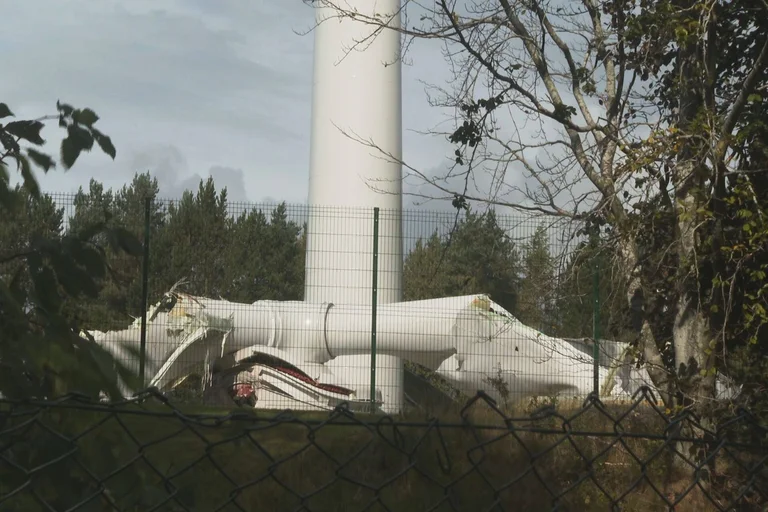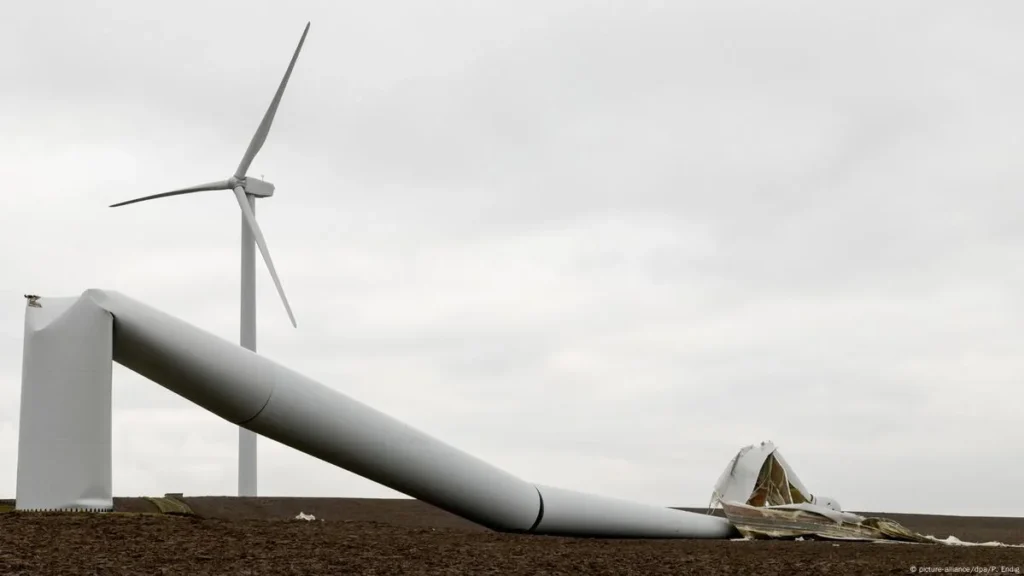
Wind Turbine Blade Crash In Perth What Really Happened
Wind turbine blade crash. In September 2025, the city of Perth experienced a dramatic & unexpected incident. A huge wind turbine blade at the Aviva site in Pitheavlis crashed in the middle of the night.
Where Did the Wind Turbine Crash Happen?
The incident happened in Pitheavlis, Perth, Scotland, at the Aviva building. Aviva placed the 77 m (253 ft) high wind turbine in late 2024 as part of its pledge to reduce emissions and promote renewable energy goals. The wind turbine blade crash was even more concerning because the area is known for being close to residential neighborhoods & walking areas. The fact that the blades crashed only a few yards from a public walkway raised questions about what might have happened if anyone had been in the area at the time.
When Did It Happen?
The turbine blades separated shortly before 1 a.m. on Friday, September 12, 2025. Most residents were asleep, but some reported hearing an “Almighty Break” followed by a heavy crashing sound. Initially, locals thought it was thunder or a construction accident, only to discover later that one of the city’s tallest wind turbines had broken.

What caused the incident?
Although the official investigation is still ongoing, according to The Courier, reports suggest some types of engineering faults may have caused the blades to fall. The tower itself was left standing, but it suffered a large dent and structural damage at the top, where the blades broke off.
Since the turbine was less than a year old, experts don’t think simple wear and tear caused the failure. They’re now looking into potential issues with the design, installation, or structural integrity. Investigators will need to carefully examine whether this was just a one-time technical fault or if it points to a bigger safety concern that could affect similar turbines across the UK.
Why This Accident Matters Beyond Perth?
The Perth turbine accident of 2025 was not just a local incident. It quickly gained global attention because wind energy has become a central part of the UK’s plan to fight climate change. Scotland, in particular, leads in wind power, generating clean electricity for homes and businesses with thousands of turbines.
When the Aviva wind turbine accident was reported, it caused people to raise serious questions about the safety risks of wind turbines. How safe are these big machines? Can they withstand extreme weather? And what does this mean for future energy projects? This incident highlights the inherent risks of traditional wind turbines. New bladeless wind turbines, with their innovative design, may reduce these safety concerns in the future. Unlike conventional turbines, which rely on large, heavy blades, bladeless turbines use a simpler design that eliminates the risks of blade failures.
What Actions Were Taken After the Crash?
The Scottish Fire & Rescue Service was sent to the location within an hour of the incident, & they arrived at 2:01 AM. After securing the area and confirming that there was no fire or smoke, they handed the situation over to Aviva’s security team. Their priority was to make sure the surrounding area was safe. Firefighters checked for sparks, smoke, or any signs of fire that might have resulted from the impact.
Once they confirmed that there was no immediate danger, they handed the site over to Aviva’s security team. They set up barriers to prevent people from entering the accident zone, as the fallen blades lay dangerously close to a public walkway. They also notified the local council and told the inspectors to assess the structural condition of the remaining tower. Meanwhile, the company temporarily shut down operations around the turbine to prevent any further risk.
Although the situation was brought under control quickly, the official investigation into the cause of the crash was left to engineering experts and regulatory authorities. It is their responsibility to determine whether a maintenance gap, installation problem, or design flaw caused the failure.
Political and Public Response:
This incident prompted political leaders across Scotland to express immediate reactions. Murdo Fraser, Scottish Conservative MSP for Mid Scotland and Fife, called the event “unbelievable” and demanded an “urgent inquiry” into the incident. He said, “It could have been a lot worse, but luckily, there were no casualties.”
First Minister John Swinney, who had officially opened the turbine less than a year earlier, described the incident as “troubling” and emphasized that “it is vital that the cause is fully investigated and that lessons are learned to ensure this cannot happen again.
He also called on Aviva to “engage openly with the public” about the incident and its consequences.
Why This Wind Turbine Blade Crash Incident Matters
This crash is more than just a technical failure; it highlights important issues about renewable energy projects.
- Public Safety Risks: Turbine blades that fall can be extremely dangerous. Fortunately, no one was harmed in this incident, but if it happens again near residences, walkways, or places of employment, it could prove fatal.
- Reliability of Renewable Energy: Wind energy is marketed as dependable, sustainable, and safe. If no clear answers or solutions are offered, a high-profile failure like this could erode public confidence.
- Failure in Early Life: Since the turbine was only a year old, it is unlikely that normal wear and tear was the cause of the problem. Instead, it indicates more serious issues with engineering, design, or installation.
- Regulation and Oversight: Such incidents show the importance of stricter safety inspections and robust monitoring systems for recently installed turbines.
Wind Power & Safety in the UK:
The UK leads the world in wind energy, with Scotland playing a central role due to its strong coastal winds and open landscapes. People see wind turbines as a key part of the country’s plan to cut carbon emissions and transition to cleaner energy. However, the Perth turbine crash shows that even green technology needs strict safety checks. Engineers design modern turbines to last for decades, but accidents like this raise questions about engineering, quality, maintenance, and public safety. Experts believe that, while such incidents are rare, they must thoroughly investigate each failure to keep future projects safe and reliable. If renewable energy loses public trust, it could slow down the UK’s progress toward its net-zero goals.
The Perth turbine accident highlighted the safety risks of conventional wind turbines. As the UK and other countries seek to expand their renewable energy infrastructure, bladeless wind turbines are emerging as a promising alternative. These turbines could significantly reduce the risk of blade failure and related accidents, directly addressing some of the safety concerns raised by the Perth incident.
The Perth wind turbine blade crash reminds us that even as we transition toward greener energy solutions, we must prioritize safety. Although the accident was rare, it emphasizes the importance of regular maintenance, improved design, and stricter safety protocols to guarantee the reliability of wind turbines. Moving forward, we can apply the lessons learned from this incident to make wind power even safer, ensuring it continues to play a crucial role in the UK’s renewable energy strategy and the global fight against climate change.
FAQs
Q1. What are the risks of wind turbine blade failures?
Ans. During downtime, a malfunctioning gearbox can shut down the turbine completely, producing no energy.” In terms of lost production and repair expenses, this is one of the most costly failures.
Q2. What’s being done to prevent future wind turbine crashes?
Ans. Authorities and manufacturers are improving turbine designs, enhancing safety measures, and enforcing more frequent inspections.
Q3. Do wind turbines affect human health?
Ans. Although wind turbines generate sound pressure, there is little to no exposure that could harm human health if the frequency is at or below the threshold of human perception and the sound pressure level is low in nearby homes.
Q4. What’s being done to prevent future wind turbine crashes?
Ans. Improvements in turbine design, better safety protocols, and regular inspections are being implemented to reduce risks.
Read more related articles: https://www.climatechallange.com/new-bladeless-wind-turbine-generates-clean-energy-without-harming-birds/